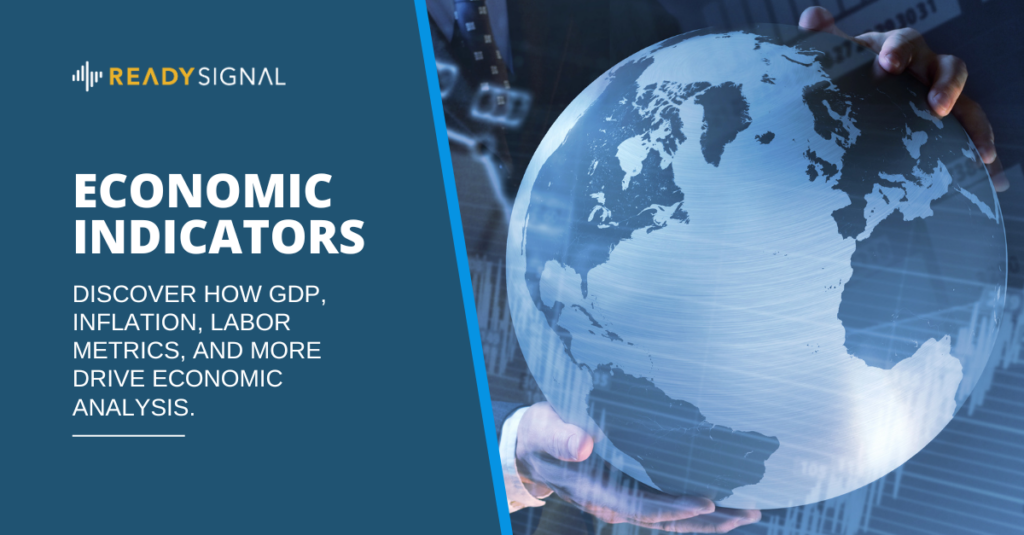
Tracking the economy’s trajectory depends on reliable indicators that provide insights into economic health and future direction. Below are the essential metrics economists review to make well-rounded assessments.
1. GDP (Gross Domestic Product)
Real GDP is a primary gauge of economic growth. Economists monitor it to measure the total value of goods and services produced, adjusted for inflation. Recent quarterly comparisons show the short-term trajectory, while percent change from previous quarters provides insights into economic acceleration or slowdown. For deeper analysis, the Decomposition of Real GDP breaks GDP down into components, helping economists pinpoint growth drivers.
2. Households
Household metrics illuminate consumer behavior, a fundamental driver of economic growth. Economists track Retail Sales for consumer spending patterns and Consumer Spending and Income for broader household financial health. Automobile and Light Truck Sales serve as a proxy for consumer confidence, while the Personal Saving Rate and Household Net Worth reflect savings trends and wealth. Housing metrics, including Existing Single-Family Home Sales, New Single-Family Home Sales, and Housing Starts & Permits for single- and multi-family units, provide insights into investment and affordability.
3. Labor Market
Labor market indicators highlight economic stability and growth potential. Nonfarm Payroll Employment captures total employment changes, while the Unemployment Rate shows available workforce. Labor Utilization Measures and the Non-Employment Index help reveal underemployment and labor slack. Other metrics like Labor Market Flows, Labor Force Participation, and Aggregate Weekly Hours signal workforce dynamics, while Average Hourly Earnings, Employment Cost Index, Labor Productivity, and Unit Labor Costs provide insights into compensation and productivity.
4. Manufacturing
Manufacturing strength reflects economic demand and productivity. Industrial Production and Capacity Utilization gauge output and utilization in manufacturing. Additional metrics like Manufacturers’ New Orders, Core Capital Goods, and Business Inventory-Sales Ratios provide insights into future production plans and demand-supply alignment.
5. Trade
Trade metrics are vital for understanding a country’s global economic engagement. The Balance of International Trade measures the difference between exports and imports, while the Exchange Value of the U.S. Dollar affects import costs and export competitiveness, with direct implications for economic growth and inflation.
6. Inflation
Inflation gauges, including the Personal Consumption Expenditure (PCE) Price Index, Consumer Price Index (CPI), and Producer Price Index (PPI), track changes in prices across goods and services. Commodity Price Indexes and Crude Oil Prices impact production costs and purchasing power, while TIPS Inflation Compensation gives insights into inflation expectations.
7. Investment
Investment in physical and intellectual assets signals business confidence and future growth potential. Real Investment in Nonresidential Structures and Private Construction data reveal business infrastructure trends, while Real Nonresidential Fixed Investment provides an overarching measure. Investment in Equipment and Intellectual Property signal how businesses are positioning for future demand and innovation.
8. Monetary Policy
Monetary policy affects borrowing, spending, and investment rates. The Federal Reserve System Assets and various Monetary Policy Instruments reflect the Fed’s stance, while the Real Federal Funds Rate shows adjusted interest rate trends. Economists also look at the FOMC Statements and Fed Funds Futures for policy directions.
Ready Signal: Your Source for Economic Indicators
The sources for the data series above include the Bureau of Economic Analysis, Federal Reserve Board of Governors, Census Bureau, Autodata Corporation, National Association of Realtors, Institute for Supply Management, Bureau of Labor Statistics, and the New York Mercantile Exchange. Ready Signal provides these data series in a clean, accessible format ready to be incorporated directly into your models, enabling you to build forecasts as robust as those used by policy makers. If you uncover insights from this data or need further guidance, our team is here to support you. We can help you interpret results and expand your analysis by incorporating our extensive library of macroeconomic indicators like those listed above and many more.
Browse our data catalog to learn more about the features that can help fuel your data practice: Key Macroeconomic Indicators Economists Rely on for Economic Forecasts
If you’re curious, take a look at our Data Catalog to see how our curated list of most relevant data sources can help you.
Data Catalog | Ready Signal
